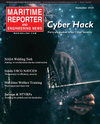
Page 11: of Maritime Reporter Magazine (September 2018)
Maritime Port & Ship Security
Read this page in Pdf, Flash or Html5 edition of September 2018 Maritime Reporter Magazine
ceives protection is essential in continu- gated and sanitized information. to pipeline safety and offshore transport. Feedback magazine.
ing public cooperation in statistical pro- Numerous federal agencies now ad- Almost all oil and gas companies op- In the early 1990s (prior to enactment grams. To that end, CIPSEA provides minister programs that utilize con? - erating on the OCS have internal safety of CIPSEA), the U.S. Coast Guard at- that an of? cer, employee, or agent of a dential reporting systems authorized data reporting programs. However, tempted to institute a maritime near-miss federal agency acquiring information by CIPSEA. These agencies include, due to legal and commercial concerns, reporting program similar to the FAA for exclusively statistical purposes who among others, the Department of Agri- these data were not being shared widely ASRS program for aviation. The attempt willfully discloses the information to a culture, the Department of Justice, the among stakeholders. SafeOCS provides ran into a stone wall when the Depart- person or agency not entitled to receive Department of Energy, and the Social a solution to these concerns by offering ment of Justice (DOJ) strongly objected. it shall be guilty of a class E felony and Security Administration. The Depart- operators and employees a con? dential The DOJ position was that once the fed- imprisoned for not more than ? ve years ment of Energy alone utilizes the CIP- method to share important equipment eral government acquired information of or ? ned not more than $250,000, or both. SEA con? dential reporting program in failure and safety data. potential wrongdoing there should be no
The Of? ce of Management and Budget 11 separate industry survey programs. The aggregated data can be used to re- self-imposed limits on use of that infor- (OMB) has published guidance to federal The Bureau of Safety and Environmen- duce the risk of major events, including mation. They conceded that they had not agencies on implementation of CIPSEA. tal Enforcement (BSEE) recently insti- loss of life or property and environmen- been particularly vigilant when the FAA
Various federal agencies have since ad- tuted its own con? dential safety report- tal harm. instituted its ASRS program, but they opted programs under CIPSEA to col- ing system, called SafeOCS. Personnel Demark, Sweden, and Finland have opposed any further spread of the con- lect, sanitize, and disseminate industry in the offshore oil and gas industry may national near-miss reporting systems for cept. That initial USCG effort for a near- information relating to safety and related submit con? dential safety reports to the their marine industry. The Nautical Insti- miss reporting program ended there.
issues. Reports collected under CIPSEA Department of Transportation (DOT) tute, an international group of maritime Now, though, Congress has spoken are immune from legal process and may Bureau of Transportation Statistics professionals headquartered in London, and strongly supports this type effort. It not be admitted into court. Those reports (BTS), which performs the con? dential- has operated the Mariners’ Alerting and is time for the Coast Guard, with the sup- are also exempted from the Freedom of ity tasks for BSEE that NASA performs Reporting Scheme (MARS) since 1992. port of the maritime industry, to institute
Information Act (FOIA). Information for the FAA. Selected near-miss incidents are pub- a maritime near-miss reporting program. provided in such a report may not be dis- The SafeOCS con? dential reporting lished in their monthly Seaways maga- For years it has worked for the FAA and closed in identi? able form for any non- system collects and analyzes data to ad- zine. Since 2003, the UK’s Con? dential the aviation industry. It now works for statistical purpose without the informed vance safety in oil and gas operations Hazardous Incident Reporting Scheme numerous other federal agencies. Con? - consent of the provider of the informa- on the outer continental shelf (OCS). It (CHIRP) collects near-miss incident re- dential near-miss reporting will work for tion. The reports are submitted directly facilitates the capture of essential infor- ports worldwide. It operates as a chari- the bene? t of the Coast Guard and the to the authorized statistical agency, not mation about accident precursors and table trust and started out focused on the maritime industry, but only if there is the to the agency that established the pro- potential hazards associated with off- aviation sector. Findings and near-miss wide support to restart the process. gram and ultimately utilizes the aggre- shore operations, including risks related reports are published in the quarterly www.marinelink.com 11
MR #9 (10-17).indd 11 MR #9 (10-17).indd 11 9/5/2018 1:07:13 PM9/5/2018 1:07:13 PM

 10
10

 12
12
